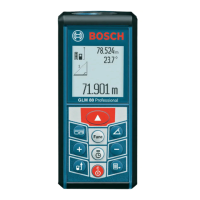around the reference plane and
measure distance “1” as for a
length measurement.
Upon completion
of the measurement,
the result for the
sought distance
“X” is displayed in
the result line c.
The measuring values for the
distance “1” and the angle “α”are
displayed in the measured-value
lines a.
b) Double indirect height
measurement (see figure D)
Press the function-mode button 4
until the indication for double
indirect height measurement
appears on the display.
Measure distances “1” and “2” in
this sequence as for a length
measurement.
Upon completion
of the measurement,
the result for the
sought distance
“X” is displayed in
the result line c.
The measuring values for the
distances “1”, “2” and the angle
“α” are displayed in the
measured-value lines a.
Pay attention that the reference
plane of the measurement (e.g.
the rear edge of the measuring
tool) remains exactly at the same
location for all individual
measurements within a measuring
sequence.
c) Indirect length measurement
(see figure E)
Press the function-mode button 4
until the indication for indirect
length measurement appears
on the display.
Pay attention that the measuring
tool is positioned at the same
height as the sought measuring
point. Now, tilt the measuring tool
around the reference plane and
measure distance “1” as for a
length measurement.
Upon completion
of the measurement,
the result for the
sought distance
“X” is displayed in
the result line c.
The measuring values for the
distance “1” and the angle “α”are
displayed in the measured-value
lines a.
Wall Surface Measurement
(see figure F)
The wall surface measurement is
used to determine the sum of
several individual surfaces with a
common height.
In the example shown, the total
surface of several walls that have
the same room height A, but
different lengths B, are to be
determined.
For wall surface measurements,
press the function-mode button 4
until the indicator for wall surface
measurement appears on the
display.

